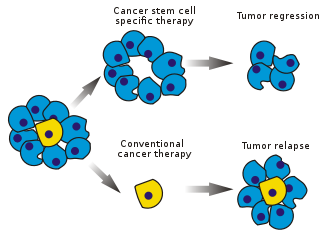
Cancer stem cells (CSCs) are cancer cells (found within tumors or hematological cancers) that possess characteristics associated with normal stem cells, specifically the ability to give rise to all cell types found in a particular cancer sample. CSCs are therefore tumorigenic (tumor-forming), perhaps in contrast to other non-tumorigenic cancer cells.[1] CSCs may generate tumors through the stem cell processes of self-renewal and differentiation into multiple cell types. Such cells are hypothesized to persist in tumors as a distinct population and cause relapse and metastasis by giving rise to new tumors. Therefore, development of specific therapies targeted at CSCs holds hope for improvement of survival and quality of life of cancer patients, especially for patients with metastatic disease.
Existing cancer treatments have mostly been developed based on animal models, where therapies able to promote tumor shrinkage were deemed effective. However, animals do not provide a complete model of human disease. In particular, in mice, whose life spans do not exceed two years, tumor relapse is difficult to study.
The efficacy of cancer treatments is, in the initial stages of testing, often measured by the ablation fraction of tumor mass (fractional kill). As CSCs form a small proportion of the tumor, this may not necessarily select for drugs that act specifically on the stem cells. The theory suggests that conventional chemotherapies kill differentiated or differentiating cells, which form the bulk of the tumor but do not generate new cells. A population of CSCs, which gave rise to it, could remain untouched and cause relapse.
Cancer stem cells were first identified by John Dick in acute myeloid leukemia in the late 1990s. Since the early 2000s they have been an intense cancer research focus.[2] The term itself was coined in a highly cited paper in 2001 by biologists Tannishtha Reya, Sean J. Morrison, Michael F. Clarke and Irving Weissman.[3]
- ^ Cite error: The named reference
:0was invoked but never defined (see the help page). - ^ Mukherjee, Siddhartha (2010-10-29). "The Cancer Sleeper Cell". New York Times. Retrieved 15 July 2014.
- ^ Reya T, Morrison SJ, Clarke MF, Weissman IL (November 2001). "Stem cells, cancer, and cancer stem cells". Nature. 414 (6859): 105–11. Bibcode:2001Natur.414..105R. doi:10.1038/35102167. hdl:2027.42/62862. PMID 11689955. S2CID 4343326.